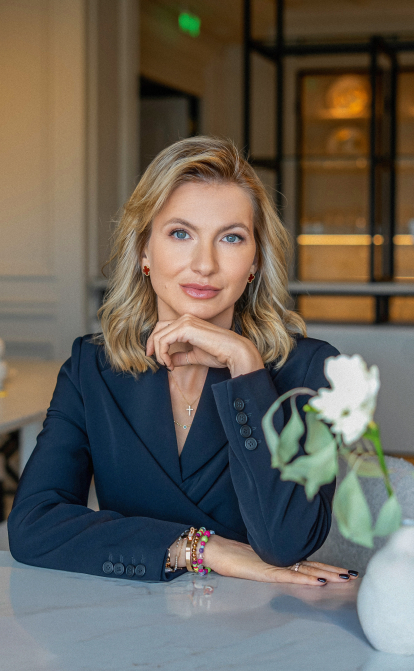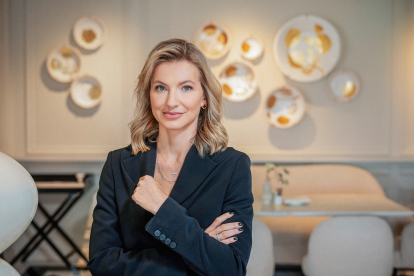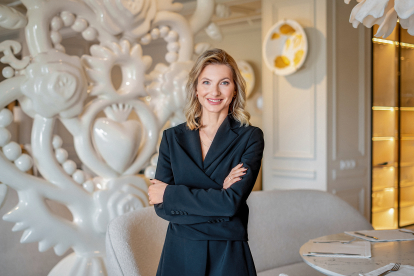After years of success in the hotel industry, Elizaveta Yurusheva boldly decided to completely change her professional path and dive into fashion, turning her lifelong passion for aesthetics and service into her fashion label.
«My clothing is about confidence and comfort, about a femininity that doesn’t shout, but shines,» says Elizaveta Yurusheva, 37, the founder of the premium fashion brand ELY ELY. Before launching the brand, she spent over 17 years managing and opening luxury hotels such as the Fairmont Grand Hotel Kyiv, InterContinental, and Riviera House in Kyiv.
Following the outbreak of the full-scale war, Yurusheva relocated to Milan with her three children and decided to pursue a dream she had long cherished: to create her clothing brand. She enrolled at Istituto Marangoni, one of Europeʼs leading fashion schools. From there, she built her team, experimented with fabrics, and learned the craft of sewing. After several unsuccessful attempts, she completely restructured the process, taking personal control over pattern making and production management.
Launched in 2024, ELY ELY now operates a full cycle of collection design, production across Italy, Romania, and Mongolia, and international sales. The brand focuses on garments made from natural fabrics and is already present in markets such as Japan, Italy, and the United States. The debut collection includes suits, jackets, dresses, tops, skirts, and accessories. The minimalist designs focus on fit and premium materials like natural wool, silk, and cashmere.
At its core, the brand champions timeless, high-quality pieces designed for longevity. How did a seasoned hotel executive find the courage to start a fashion brand — and succeed in a new industry?
The Formula for Fashion Business
You spent over 13 years in the hotel industry before moving into fashion. What inspired the change?
Fashion has always been my dream. I was obsessed with it from a young age, my mother didn’t know what to do with me because I could spend hours flipping through fashion magazines. Then life happened: the family business, returning from Austria to Ukraine, and a career in hospitality at InterContinental and Riviera House. I simply didn’t have time for my dream.
Fashion is an industry you have to breathe in. I always wanted to be involved in the creative process, not just be a buyer or a store owner. When the full-scale war began, I moved to Milan with my children without any big plans. I enrolled in a Master’s program in Fashion Business at Istituto Marangoni to keep developing myself.
Inside, everything was moving toward a fashion project. And one day, I decided — I’m going to try.
When you began your entrepreneurial journey, did you lead with an idea, intuition, or analysis?
It’s 50% fate. The rest is intuition, analysis, and experience. I have an analytical mind — I can quickly find solutions for any business because I’ve worked across many industries: from wood and ceramic tiles to restaurants and hotels. Fashion is a business. There’s a budget, a structure, a product, and marketing. Sure, it has a much larger creative side, but strip away the glamour, and it’s pure mathematics.
I work systematically. I always have a clear vision of what I want to achieve. I know what’s missing on the market and what I want to offer women.
What in your experience shaped your leadership qualities and gave you the confidence to start your brand?
I had 600 employees under my management across two hotels. My decisions determined how everything would move forward. My biggest lesson from those years is that you can’t build anything alone. The most valuable leadership quality is the ability to gather people around you who believe in you.
Now I’m trying to do the same with my brand, and it’s hard. I have three children, other ongoing projects, and a brand run by just five people. I iron the clothes myself, handle deliveries, and manage production. But I know: without a team, you can’t build anything lasting. That’s my biggest challenge right now: building my team.
What does being an entrepreneur in the fashion industry mean to you? What challenges and opportunities does this space bring?
I have no right to make mistakes. If someone doesn’t like an item, they wonʼt come back. I mostly work through e-commerce and retail stores, which means I donʼt have direct contact with customers, and that’s tough, because you don’t get instant feedback.
Another challenge is competition. Fashion brands often operate with million-dollar budgets. You can throw all your money into advertising, but that’s not my path. I don’t just want a one-time sale. I want to create something tangible. I need to release pieces that highlight a woman, not overshadow her. And they must be built to last.
How did your studies at Istituto Marangoni shape you as an entrepreneur? What do you value most from that experience?
Marangoni opened my eyes: fashion is not magic — it’s business. Before that, I thought fashion was unreachable, purely creative, and not for someone like me. But the industry is challenging and structured, and it completely consumes you.
The professors were real-world professionals, buyers, managers, and people who had worked for major brands. Through them, I realised how important it is to believe in yourself. In fashion, you are constantly questioned. Your ideas, taste, and creations can all be rejected. You have to learn to withstand that and not give up.
Building ELY ELY: The Journey of Launching a Brand
How did you create the first collection for ELY ELY? How did you select suppliers and materials?
The first collection was a challenge. I hired two consultants, one for creative direction and another to help with sourcing suppliers. But when the collection was ready, I didn’t like it, so I redid everything.
Now, I sketch everything myself, create technical drawings, visit fabric exhibitions, find inspiration in vintage pieces, and analyse trends. I break the collection down by fabric type, thinking through every piece: how it will be worn, how it will hold its shape, the density, the feel. I have a product manager with 30 years of experience who helps with the technical execution. But every colour, every shape, every detail passes through my hands.
What was the initial investment to launch ELY ELY?
It was about €220,000. And I’ll be honest — that’s a tiny amount for an international brand. Much of it went into renovations, setup, and basic operational needs. But I couldn’t justify pulling money from other businesses to fund my dream — that wouldn’t have been fair. So I set this limit for myself and work within it. Maybe with a bigger budget, I would have achieved results faster — or maybe I would have failed sooner. This way, I understand my financial horizon — moving step by step. That’s why, for now, I don’t have a large team and handle many processes personally.
How did you define success during the brand’s early stages? What metrics or business indicators guided you?
First, feedback matters most from buyers, my team, and others. But the ultimate guide is my inner sense. I have always intuitively felt where the market is moving and what is truly at any moment. Of course, I track sales, but not just sales volume. In the fashion industry, it’s crucial that a store not only buys your collection but sells it successfully. Otherwise, they won’t come back. For example, Harrods in London showed strong interest in buying my collection but said, «This is only your second collection. How can we be sure you’ll still be around next year?»
And I completely understand them — it’s a tough market.
On Building ELY ELY
What factors did you consider when selecting materials, and why did you choose Mongolian cashmere?
I work with Italian and Mongolian cashmere because they offer exceptional quality and a wide range of production capabilities. Both countries have modern factories equipped to create complex textures, like blends of cashmere and silk. In Italy, however, such machinery is rare and usually locked in by big brands. I use Italian cashmere primarily for handwork, sourced from southern Italy and a production facility in Romania owned by an Italian. All the materials I work with are of exceptionally high quality. I consciously avoid using polyester, even when it would be more profitable. My principle is simple: I create clothes I want to wear for years.
What are the three main needs you want your brand to address?
Clothing works on a woman psychologically. When she walks into a room, she wants to feel good. Women’s clothing is often uncomfortable: dresses and jackets can be stiff, making you look good but feel restricted. I want to create comfortable clothing. I have a packed schedule and lots of meetings; I can’t afford to feel constrained. That’s why I work with knits — they’re flexible, allowing you to sit, stand, and move while highlighting femininity.
Another important point: I donʼt like clothing that overshadows the woman wearing it. Some designs shout first, and the woman comes second.
I want my clothes to amplify a womanʼs beauty, not drown it out.
Who do you see as your main competitors in the premium segment in Ukraine and globally?
I donʼt see competitors in Ukraine — not because I think Iʼm better, but because the market is vast, and everyone can find their audience. Globally, I recognise brands I align with: Extreme Cashmere, The Elder Statesman, Gabriela Hearst, Guest in Residence by Gigi Hadid, and Almeida. I understand the niche I’m entering. But I’m not trying to overshadow anyone — I just want to do what I feel. And I believe my customer will find me. As one designer once told me, «In our business, sometimes you just need more time for people to see you.»
What is the demand for premium fashion products in Ukraine? How do you plan to develop the market for Ukrainian consumers?
The Ukrainian market is very solvent. Clothing is cheaper here, so people are used to buying more pieces. But I believe in this audience. At the moment, I haven’t had any e-commerce purchases from Ukraine, and I understand why. Ukrainian women want to touch and try on clothes first. I’m the same way. That’s why I plan to open a physical store in Kyiv. It’s my city, my home — and I want to be here. For me, serving Ukrainian women is essential because they are incredible. Often, all they lack is the kind of confidence that’s more visible in European women. We have gorgeous, well-groomed women. And I can see a new demand forming, not just for a brand name, but for real quality. Not everyone is used to the idea that clothing can be exceptionally high quality and understated, but that mindset is changing.
Where do you see ELY ELY in the next few years?
In three years, I plan to open my stores in Paris, Milan, New York, and Kyiv. Paris is attractive because of the volume of tourists, which helps build brand awareness quickly. I already have customers in New York, and the market responds well there. But for me, it’s not just about physical presence, it’s about building a brand that’s truly worthy of its reputation.
The most important thing for me is customer trust. I want every woman to be able to say, «My favourite brand is ELY ELY.» That’s real success.
What three pieces of advice would you give entrepreneurs who are just starting and want to build a quality, successful fashion brand?
First, don’t give up. No matter how hard it gets or how stuck you feel on paper, you canʼt quit. The fashion business is very volatile. Today it’s a no, tomorrow it’s a yes. You have to budget for the long term. This isn’t the kind of business where you launch a collection and instantly make millions. It doesn’t work like that.
Second, be systematic. Those who work consistently are the ones who win. Even when it’s tempting to cut corners or save here and there, don’t. Everything needs structure and planning. Fashion is mathematics, and it demands order.
Third, believe in your product. If you don’t love it, no one else will. You have to create something people would buy at three in the morning — and not regret it. It has to be right, universal, and real.
Вы нашли ошибку или неточность?
Оставьте отзыв для редакции. Мы учтем ваши замечания как можно скорее.




